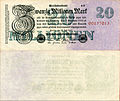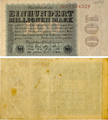Paper mark
Papiermark is an unofficial name for the banknotes denominated in Mark or the currency of the inflation years from 1919 to 1923 in the Weimar Republic . It was replaced on November 15, 1923 by the Rentenmark and in 1924 by the Reichsmark .
Formally, the paper mark is the same currency as the mark of German currency introduced in 1871 when the German Empire was founded . The German Mark currency based on the weak form of the gold standard , in which denominated in Mark banknotes and divisional coins from the Reichsbank were exchanged full of gold coins. Banknotes in circulation and Reichsbank balances did not have to be 100% covered by gold stocks (gold core currency). However, the Reichsbank's obligation to exchange for gold was lifted on August 4, 1914 with the beginning of the First World War . Since the Reich financed the costs of warfare only to a lesser extent through tax increases and war bonds , but to a large extent through the issue of paper money , there was already considerable inflation during the war years . Mark and pfennig coins containing precious metals disappeared immediately from circulation in 1914.
The term paper mark came about when the mark was extremely devalued by the galloping inflation in Germany in 1923 . One US dollar cost 4.2 trillion marks at its peak. When printing paper mark banknotes from denominations of “1 billion marks”, only words were used for the amounts “billion” and “trillion” for reasons of space and clarity. The banknotes were recently printed on one side, and in some cases earlier denominations were overprinted after their actual cancellation with new, higher values.
The era of the paper mark was officially ended on December 31, 1923 with the commercial "paper mark closing balance", since from January 1, 1924 all German companies were only allowed to calculate according to the "gold mark opening balance". At the beginning of 1924 both paper marks with billions and trillions in value as well as the new Rentenmark notes with issue date November 1, 1923 at the rate of 1 trillion paper marks = 1 Rentenmark were in circulation. The last 5 trillion paper denominations date to March 15, 1924. Since banknotes with trillion denominations were almost completely exchanged for the new Rentenmark notes in the course of 1924, they are very rare today and fetch high collector prices. This usually does not apply to the million and smaller billion bills.
All banknotes issued before October 11, 1924 could be exchanged at the Reichsbank until June 5, 1925. However, banknotes with denominations of less than 10 billion marks had to be bundled and delivered in quantities divisible by 10 billion.
Reichsbank banknotes
literature
- Reichsfinanzhof (Ed.): Collection of the decisions and reports of the Reichsfinanzhof. Carl Gerber Publishing House, Munich 1928.
Individual evidence
- ^ Numismatic Library , accessed February 1, 2018















